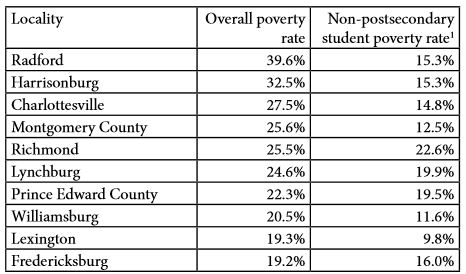As readers know, I am a data junkie, and I post a lot of maps and charts highlighting, among other things, the variations of wealth and poverty in Virginia. The data is useful in helping us understand social, economic and political dynamics of the state, but they usually come with an asterisk. Poverty rates tend to be abnormally high in college towns. Judging by the statistics, one would expect places like Blacksburg, Charlottesville, Harrisonburg, Radford and Lexington to be havens for housing projects and trailer parks. Yet to all outward appearances, they seem to be fairly prosperous places.
Clearly, the presence of large numbers of college students who are studying (and partying) rather than working full-time to earn a living are skewing the figures. As a new census brief from the Demographics Working Group at the University of Virginia observes:
Most college students report very low incomes, putting them below their respective poverty thresholds and—especially in cases of large off-campus student populations—raising the rate of poverty in the towns where they live. Yet, intuitively, we recognize that college or graduate student “poverty” means something different than poverty among the unemployed, families with children, or the persistently needy.
In calculating the official poverty rate, number crunchers make some adjustments to minimize the student amplification of poverty by excluding people living in group quarters such as college students in dormitories, older adults in nursing homes, prisoners and inmates, and military personnel in barracks. Even so college students living off-campus inflate the poverty numbers.
By removing all students involved in undergraduate or graduate education, the Demographics Work Group provides a clearer picture of what most of us would think of as “real” poverty. In the aforementioned college towns, making this adjustment cuts poverty rates in half. Even in most populous jurisdictions, such as Richmond, the adjustment creates a noticeable drop.
— JAB



